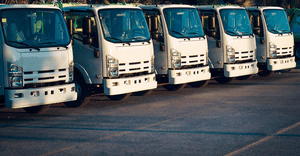Droning On and On: What’s Next for Online Delivery?
Online purchasing accounts for 10 percent of retail sales, up from 4 percent a decade ago. No one knows where it will max out, but its growth is inevitable.
Look. Up in the sky. It’s a bird. It’s a plane. It’s a drone delivering my order of freshly brewed coffee.
E-commerce fundamentally changed how we buy things. Online purchasing now accounts for 10 percent of retail sales, up from 4 percent a decade ago. No one knows where it will max out, but its continued growth is inevitable.
Online sales also have been a savior for the paper industry, providing a steady market for corrugated boxes in the face of a continued decline in the use of printed paper. Linerboard and corrugated medium mills, whose products are used to make those boxes, are increasing their production capacity in response to this increased use.
Recycling programs already see benefits and challenges from e-commerce. According to the paper industry, slightly less than half of the recycled fiber used to make paper products goes into making corrugated boxes and other packaging. More domestic capacity can only help markets.
Paper mills have long relied on retail stores for the bulk of the boxes they recycle. Boxes from those stores tend to be big, clean and easily available. With the rise of e-commerce, you and I are now putting more, smaller boxes in our recycling bins. This “browning” trend helps offset the declining amounts of newspapers and magazines we put out for recycling. However, it also means that brick-and-mortar stores have fewer boxes to recycle. Materials recovery facilities (MRFs) can also have a problem sorting our smaller boxes.
In some ways, e-commerce is nothing new. It is simply the catalog business on steroids with easily updated online shopping sites. In the newest wrinkle, “e-tailers” are looking at drones as a way to speed up delivery of your e-order.
A year ago, the Federal Aviation Administration (FAA) approved 10 regional tests of “Unmanned Aircraft Systems Integration Pilot Programs.” These tests include the use of “autonomous drones” to perform a variety of functions including delivery of medical equipment and blood, mosquito control, crop inspection, disaster response, border protection and delivery of food and packages. In late April, the FAA-certified Wing, a subsidiary of Google, was an “air carrier” in a test of drone package delivery in the Blacksburg (Virginia Tech) area of Western Virginia. Similar tests are being carried out elsewhere.
Wing has not announced what it will be delivering. Food and over-the-counter medicines are thought to be likely products. In an experiment three years ago, Wing delivered burritos to students at Virginia Tech.
What kind of packaging will drones use to protect the products they deliver? You can see examples of drone delivery on YouTube. You can even see a film of a drone delivering freshly brewed coffee in Australia. These videos don’t always give you a good view of the package inside of the delivery box. When they do, it is usually some kind of corrugated or paper box, similar to what is already used to deliver those products.
Drone delivery may not take off as quickly or as successfully as its proponents hope. It still faces considerable challenges in public acceptance, noise control and delivery cost. Even if successful, it may be used more in rural and suburban areas with no overhead power lines and limited tree cover. These are usually the sites of the YouTube videos. So far, the most successful use of drone delivery involves transporting blood and medical supplies to remote clinics in the mountainous African country of Rwanda.
Yet, we would be foolish to discount the possibility that drone delivery will take off. At this point, I don’t think that MRFs or solid waste planners have much to worry about. Five or 10 years from now, who knows. Drones may become a common delivery tool. New kinds of packages may be developed to allow them to operate more efficiently or they may use the same kind of packages used today. I have no idea if they will be more or less recyclable than the ones they are currently experimenting with. Perhaps this will be another lesson that the materials and products we use evolve along with the technologies we use. We can resist that change or learn how to make it work for us.
As for me, I don’t expect to get drone-delivered cold brew anytime soon. I’d rather enjoy the ambience of the local coffee company. I’m too much of a social animal to want to stay home and have my cold brew come to me.
Chaz Miller is a longtime veteran of the waste and recycling industry. He can be reached at [email protected].
About the Author(s)
You May Also Like




